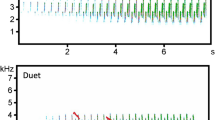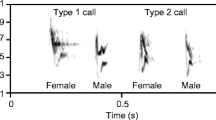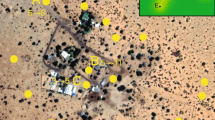Abstract.
Unmated male songbirds usually change their vocal behaviour when females enter their territories. Either the males court the females by changing the rate or pattern with which their normal long-ranging full songs are emitted, or they shift to special displays and long- or short-ranging vocalisations. In this study we quantified how female presence and behaviour affect the singing behaviour of male whitethroats. In the presence of a female the male frequently performed song flights, maybe to locate the female before it was courted, with sequences of diving-song displays. The courtship was interrupted by periods of perch songs. Female dscharp calls and short movements made the males initiate or resume courtship, whereas short horizontal jumps made the males intensify their courtship. Overall, the males changed their dual-function song activity in females' presence by emitting fewer perch songs and more flight songs. The quiet diving songs were only emitted during direct courtship of a female. The song types emitted immediately before, during, and after courtship are all highly variable, thus allowing for a quick assessment of the male's song repertoire. The courtship was also interrupted by periods of male woid calling, a call that is known to have a deterring effect on rival males. Bouts of woid calls were usually followed by song flights, again probably to locate the female that might have moved out of sight, or maybe to locate potential rival intruders. The latter was supported by an increased intrusion rate during female presence.



Similar content being viewed by others
References
Amundsen T (2000) Why are female birds ornamented. Trends Ecol Evol 15:149–155
Amundsen T, Forsgren E, Hansen LTT (1997) On the function of female ornaments: male bluethroats prefer colourful females. Proc R Soc Lond B 264:1579–1586
Balsby TJS (2000a) The function of song in whitethroats Sylvia communis. Bioacoustics 11:17–30
Balsby TJS (2000b) Song activity and variability in relation to male quality and female choice in whitethroats Sylvia communis. J Avian Biol 31:56–62
Balsby TJS (2001) Vocal communication in the whitethroat Sylvia communis. PhD thesis, University of Copenhagen
Balsby TJS, Dabelsteen T (2002) Female influence on male courtship in whitethroats Sylvia communis. An interactive experiment using visual and acoustic stimuli. Anim Behav 63:251–257
Baptista LF (1978) Territorial, courtship and duet songs of the Cuban grassquit Tiaris canora. J Ornithol 119:91–101
Bergmann H-H (1973) Konstitutionsbedingte Merkmale in Gesängen und Rufen europäischer Grasmücken (Gattung Sylvia). [Constitution-dependent characteristics of songs and calls in European warblers (Genus Sylvia)] Z Tierpsychol 42:315–329
Bergmann H-H, Helb H-W (1982) Stimmen der Vögel Europas. BLV Verlagsgesellschaft, Munich
Birkhead TR, Møller AP (1992) Sperm competition in birds – evolutionary causes and consequences. Academic Press, London
Bischof H-J (1985) Der anteil akustischer Komponenten an der Auslösung der Balz Männlicher Zebrafinken Taenopygia guttata castanotis. J Ornithol 126:273–279
Capp MS, Searcy WA (1991) An experimental study of song type function in the bobolink Dolichonyx oryzivorus. Behav Ecol Sociobiol 28:179–186
Castellan NJ (1979) The analysis of behaviour sequences. In: Cairns RB (ed) The analysis of social interactions: methods, issues, and illustrations. Erlbaum, Hillsdale, N.J., pp 81–116
Catchpole CK (1987) Bird song, sexual selection and female choice. Trends Ecol Evol 2:94–97
Catchpole CK, Slater PJB (1995) Bird song biological themes and variation. Cambridge University Press, Cambridge
Dabelsteen T (1978) An analysis of the song-flight of the lapwing Vanellus vanellus L. with respect to causation, evolution and adaptations to signal function. Behaviour 66:136–178
Dabelsteen T (1988) The meaning of the full song of the blackbird Turdus merula to untreated and estradiol treated females. Ornis Scand 19:7–16
Dabelsteen T, McGregor P K, Lampe HM, Langmore NE, Holland J (1998) Quiet song in song birds: an overlooked phenomenon. Bioacoustics 9:89–105
Eens M, Pinxten R, Verheyen RF (1993) Function of the song and song repertoire in the European starling Sturnus vulgaris: an aviary experiment. Behaviour 125:51–66
Howard HE (1914) British warblers – a history with problems of their lives, vol 1. RH Porter, London
Lack D (1965) The life of the robin, 4th edn. Whitherby, London
Lind H (1959) Studies on courtship and copulatory behaviour in the goldeneye Bucephala clangula. Dansk Orn For Tidsskrift 53:177–219
Lind H (1961) Studies on the behaviour of the black-tailed godwit Limosa limosa. (Medd. fra Naturfredningsrådets reservatudvalg nr. 66) Munksgaard, Copenhagen
Mantel N (1969) The detection of disease clustering and a generalized regression approach. Cancer Res 27:209–220
Merilä J, Sorjonen J (1994) Seasonal and diurnal patterns of singing and song flight activity in bluethroats Luscinia svecica. Auk 111:556–562
Monaghan P, Metcalfe NB, Houston DC (1996) Male finches selectively pair with fecund females. Proc R Soc Lond B 263:1183–1186
Morris D (1954) The reproductive behaviour of the zebra finch Poephila guttata, with special reference to pseudofemale behaviour and displacement activities. Behaviour 6:271–322
Morton ES (1975) Ecological sources of selection on avian sounds. Am Nat 108:17–34
Patricelli GL, Uy JAC, Walsh G, Borgia G (2002) Male displays adjusted to female's response. Nature 415:279–280
Petersen BS (1984) The imitation capability of the Marsh warbler – an adaptation to interspecific territoriality? (in Danish) Cand. scient. thesis, Institute for Population Biology, Copenhagen
Searcy WA, Yasukawa K (1990) Use of the song repertoire in intersexual contexts by male red-winged blackbirds. Behav Ecol Sociobiol 27:123–128
Searcy WA, Yasukawa K (1996) Song and female choice. In: Kroodsma DE, Miller EH (ed) Ecology and evolution of acoustic communication in birds. Cornell University Press, Ithaca, N.Y., pp 454–473
Searcy WA, Eriksson D, Lundberg A (1991) Deceptive behavior in pied flycatcher. Behav Ecol Sociobiol 29:167–175
Siegel S, Castellan NJ (1988) Nonparametric statistics for the behavioural sciences. McGraw-Hill, New York
Smith JW (1977) The behaviour of communication – an ethological approach. Harvard University Press, Cambridge, Mass.
Snow DW (1958) A study of blackbirds. British Museum (Nat Hist), London
Tinbergen N (1951) The study of instinct. Clarendon Press, Oxford
Tinbergen N (1953) Social behaviour in animals. Chapman and Hall, London
Zann RA (1996) The zebra finch – a synthesis of field and laboratory studies. Oxford University Press, Oxford
Acknowledgements.
We thank Mols laboratoriet and Fussingø Statsskovsdistrikt skovpart Mols for permitting us to work in the area. The Danish Ringing Centre, Zoological Museum, Copenhagen administered the ringing license to TJSB. Centre for Sound Communication and Poul Hansen at the Natural History Museum Århus assisted us with equipment. Peter McGregor, Marc Naguib, Stephen Nowicki, Bill Searcy and an anonymous referee gave valuable comments on earlier versions of the manuscript. TJSB was funded by a Ph.D. scholarship from Copenhagen University. This study complies with the laws in Denmark.
Author information
Authors and Affiliations
Corresponding author
Additional information
Communicated by P. McGregor
Rights and permissions
About this article
Cite this article
Balsby, T.J.S., Dabelsteen, T. Male singing behaviour and female presence in the territory in whitethroats Sylvia communis. acta ethol 5, 81–88 (2003). https://doi.org/10.1007/s10211-002-0068-z
Received:
Revised:
Accepted:
Published:
Issue Date:
DOI: https://doi.org/10.1007/s10211-002-0068-z




